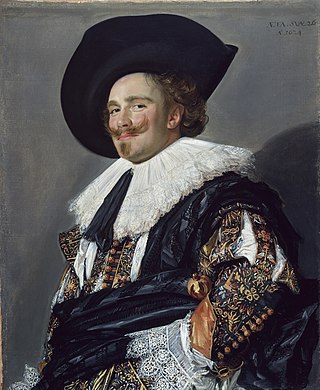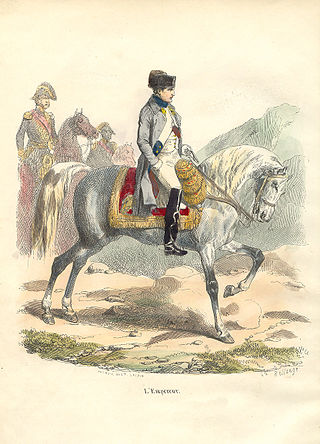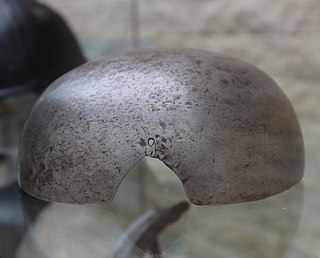Production, appearance and variation
The buff coat was worn as European military attire from around 1600 through to the 1680s. The origin of the term 'buff' in relation to the coat refers to leather obtained from the "European buffalo" (available sources do not specify what species this term means, but it most probably refers to the wisent), which also gave rise to the term buff for its light tan colour. The only source of buffalo leather in the early 17th century was Germany. Most buff coats, however, were made from thick cowhide. While mainly worn for military use, its design reflects civilian styles fashionable during the early 17th century, with a high waist and flared skirts extending to the thighs. It is related to the earlier sleeveless doublet or jerkin, likewise made of thick leather.
Made in sleeveless and sleeved variants, the very finest buff coats were made of the hide of the European elk. Buff leather was produced by a method of "oil tanning"; following treatment with lime the hide was scraped to remove the outer layer, which gave the finished product a matt surface. The hide then had cod oil worked into it in a process called "kicking" and was finally air-dried. The oiling and drying steps could be repeated. The finished leather attained its characteristic buff colour and was supple, durable and weather resistant.
Due to the thickness of the leather, the seams of these coats were all butt-jointed, with hidden or partially hidden stitches. Thread holes were punched with an awl before stitching, since needles then in use could not puncture the hide. Extant examples are lined, either with coarse linen or silk. Closures included laces threaded through eyelets, buttons, loops, and clasps. All extant English examples are closed with hooks and eyes. Many high quality examples show apparent fastenings of gold or silver tape at the front, however, these were merely decorative, the real fastenings being hidden hooks and eyes attached to the inside of the join. Some of the highest quality buff coats, typically shown in portraits of officers, had multiple stripes of gold or silver lace running lengthwise down, or hooped around, the sleeves.
Most surviving examples have sleeves, but a minority are sleeveless. Removable sleeves were common for men's clothing in the 17th century. Sleeves could be of a single thickness of leather from shoulder to wrist, or alternatively of a double thickness from the shoulder to the elbow, with a single thickness, to allow freedom of movement, to the wrist. All buff coats had deep skirts attached, which protected the upper legs of the wearer. The thickest parts of the leather were generally placed so as to protect the wearer's legs while on horseback. The extant collection of buff coats preserved at Littlecote House dating to 1649–1660, contains examples with leather varying from 0.06 to 0.22 inches (1.5 to 5.6 mm) in thickness and entire coats weighing between 4 lb 4 oz and 7 lb 8 oz (1.9–3.4 kg).

Armour or armor is a covering used to protect an object, individual, or vehicle from physical injury or damage, especially direct contact weapons or projectiles during combat, or from a potentially dangerous environment or activity. Personal armour is used to protect soldiers and war animals. Vehicle armour is used on warships, armoured fighting vehicles, and some combat aircraft, mostly ground attack aircraft.

A cuirass is a piece of armour that covers the torso, formed of one or more pieces of metal or other rigid material. The word probably originates from the original material, leather, from the French cuirace and Latin word coriacea. The use of the term "cuirass" generally refers to both the breastplate and the backplate pieces; whereas a breastplate only protects the front, a cuirass protects both the front and the back of the wearer.

A waistcoat or vest is a sleeveless upper-body garment. It is usually worn over a dress shirt and necktie and below a coat as a part of most men's formal wear. It is also sported as the third piece in the traditional three-piece male suit. Any given waistcoat can be simple or ornate, or for leisure or luxury. Historically, the waistcoat can be worn either in the place of, or underneath, a larger coat, dependent upon the weather, wearer, and setting.

Cuirassiers were cavalry equipped with a cuirass, sword, and pistols. Cuirassiers first appeared in mid-to-late 16th century Europe as a result of armoured cavalry, such as men-at-arms and demi-lancers discarding their lances and adopting pistols as their primary weapon. In the later part of the 17th century, the cuirassier lost his limb armour and subsequently wore only the cuirass, and sometimes a helmet. By this time, the sword or sabre had become his primary weapon, with pistols relegated to a secondary function.

Lamellar armour is a type of body armour, made from small rectangular plates of iron or steel, leather (rawhide), bone, or bronze laced into horizontal rows. Lamellar armour was used over a wide range of time periods in Central Asia, Eastern Asia, Western Asia, and Eastern Europe. The earliest evidence for lamellar armour comes from sculpted artwork of the Neo-Assyrian Empire in the Near East.

A jerkin is a man's short close-fitting jacket, made usually of light-coloured leather, and often without sleeves, worn over the doublet in the 16th and 17th centuries. The term is also applied to a similar sleeveless garment worn by the British Army in the 20th century. A buff jerkin is an oiled oxhide jerkin, as worn by soldiers.

A brigandine is a form of body armour from the Middle Ages. It is a garment typically made of heavy cloth, canvas, or leather, lined internally with small oblong steel plates riveted to the fabric, sometimes with a second layer of fabric on the inside.

A doublet is a man's snug-fitting jacket that is shaped and fitted to the man's body. The garment was worn in Spain, and spread to the rest of Western Europe, from the late Middle Ages up to the 17th century before turning into the stay and corset. In fact, it was in the 16th century that women started also wearing doublets This would later become the corset and stay in the 17th century. The doublet was thigh length, hip length or waist length and worn over the shirt or drawers. Until the end of the 15th century, the doublet was usually worn under another layer of clothing such as a gown, mantle, or houppelande when in public. In the 16th century it was covered by the jerkin.

The harquebusier was the most common form of cavalry found throughout Western Europe during the early to mid-17th century. Early harquebusiers were characterised by the use of a type of carbine called a "harquebus". In England, harquebusier was the technical name for this type of cavalry, though in everyday usage they were usually simply called 'cavalry' or 'horse'. In Germany they were often termed Ringerpferd, or sometimes Reiter, in Sweden they were called lätta ryttare.

The ō-yoroi (大鎧) is a prominent example of early Japanese armor worn by the samurai class of feudal Japan. The term ō-yoroi means "great armor."

The demi-lancer or demilancer was a type of heavy cavalryman in Western Europe during the 16th and early 17th centuries.

Fashion in the years 1750–1775 in European countries and the colonial Americas was characterised by greater abundance, elaboration and intricacy in clothing designs, loved by the Rococo artistic trends of the period. The French and English styles of fashion were very different from one another. French style was defined by elaborate court dress, colourful and rich in decoration, worn by such iconic fashion figures as Marie Antoinette.

Fashion in the period 1600–1650 in Western clothing is characterized by the disappearance of the ruff in favour of broad lace or linen collars. Waistlines rose through the period for both men and women. Other notable fashions included full, slashed sleeves and tall or broad hats with brims. For men, hose disappeared in favour of breeches.

Lobster-tailed pot helmet, also known as the zischägge, horseman's pot and harquebusier's pot, was a type of combat helmet. It was derived from an Ottoman Turkish helmet type. From c. 1600, it became popular in most of Europe and was especially worn by cavalrymen and officers. The helmet gradually fell out of use in most of Europe in the late 17th century; however, the Austrian heavy cavalry retained it for some campaigns as late as the 1780s.

A pelisse was originally a short fur-trimmed jacket which hussar light-cavalry soldiers from the 17th century onwards usually wore hanging loose over the left shoulder, ostensibly to prevent sword cuts. The name also came to refer to a fashionable style of woman's coat-like garment worn in the early-19th century.

The uniforms of La Grande Armée, the army of Napoleon I, are described in this article.

Scholars agree that Japanese armour first appeared in the 4th century, with the discovery of the cuirass and basic helmets in graves. During the Heian period (794-1185), the unique Japanese samurai armour ō-yoroi and dō-maru appeared. The Japanese cuirass evolved into the more familiar style of body armour worn by the samurai known as the dou or dō, with the use of leather straps (nerigawa), and lacquer for weatherproofing. Leather and/or iron scales were also used to construct samurai armours, with leather and eventually silk lace used to connect the individual scales (kozane) of these cuirasses.

Laminar armour is an armour made from horizontal overlapping rows or bands of, usually small, solid armour plates called lames, as opposed to lamellar armour, which is made from individual armour scales laced together to form a solid-looking strip of armour. Prominent examples of such armour are lorica segmentata of Ancient Rome and certain versions of samurai armour.

The secrete or secret, a French term adopted into English usage, was a type of helmet designed to be concealed beneath a hat.

Armour in the 18th century was minimalist and restricted almost entirely to cavalry, primarily to cuirassiers and, to a lesser degree, carabiniers and dragoons. Armour had been in rapid decline since the Thirty Years' War, although some archaisms had lingered on into the early years of the 18th century, like Austrian cuirassiers with buff coats and lobster-tailed helmets or Hungarian warriors with mail armour and shields. With the exception of Poland-Lithuania, which still made use of hussars wearing suits of plate armour, armour in Europe was primarily restricted to a breast- and backplate, the cuirass, and a simple iron skull cap worn under the hat. By the later 18th century, there were two contradicting developments. Many cuirassier regiments were discarding their cuirasses, while helmets in the form of so-called dragoon helmets, made of brass or leather, made a comeback among the cavalry and infantry.






















